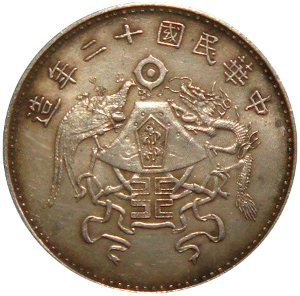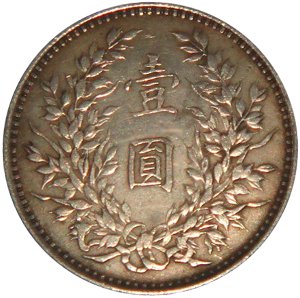Lu Xun (鲁迅 1881-1936) is recognized as one of the greatest Chinese writers of the 20th Century and the founder of modern Chinese literature.
Few people, however, are aware of Lu Xun’s contributions to Chinese numismatics. He was not only a collector of ancient Chinese coins but he also wrote a manuscript annotating Chinese coins from the 7th to the 17th Century.
According to a Xinhua news dispatch, this treatise on Chinese coins written by Lu Xun is now being published for the first time in commemoration of the 62nd anniversary of the founding of the People’s Republic of China.
The manuscript was written in 1913 while Lu Xun was working for the Ministry of Education in Peking (Beijing). During that time, he began to study ancient books on Chinese coins and he frequently went to Liulichang (琉璃厂) to buy old Chinese coins for his own collection.
Lu Xun was familiar with the famous work on Chinese coins known as Quan Zhi (泉志) written by Hong Zun (洪遵) in 1149 during the Song Dynasty. The Quan Zhi has the honor of being recognized as the world’s oldest extant coin book.
The Quan Zhi annotated the various forms of Chinese money from the very earliest times to the Song Dynasty. Lu Xun wanted to supplement this great work. In his manuscript, he wrote about Chinese coins beginning with those of the Tang and Five Dynasties and ending with the coins of the Ming Dynasty. He cataloged 1,311 different coins from this time period thus adding an additional 700 years to the field of numismatic research.
But Lu Xun’s involvement in Chinese numismatics went even further for he was actually involved in the design of one of the coins of the time.
According to an entry in Lu Xun’s diary dated August 28, 1912, he along with two colleagues, Xu Shouchang (许寿裳) and Qian Taoxun (钱韬逊), designed a twelve symbol emblem.

Dragon and Phoenix Silver Dollar
This emblem, seen on the coin at the left, was designed by Lu Xun to be the national emblem for the newly established Republic of China.
Lu Xun incorporated into the design the auspicious elements known as the Twelve Symbols (十二章), which date from the Spring and Autumn Period (770 BC – 476 BC), that had traditionally been used on the clothing of Chinese emperors.
These ancient symbols include the dragon and pheasant. However, the Chinese have traditionally mistaken the pheasant (雉) as being a phoenix (凤) and so the design is usually referred to as the “dragon and phoenix”.
Besides the dragon and pheasant (“phoenix”), the Twelve Symbols include the axe head (斧 located between the dragon and pheasant), rice (粉米 small circles on the axe), the sun (日 above the axe), the moon (月 the dragon’s horn), fire (火 on dragon’s body), the fu (黻 under the axe), stars (星辰 the three dots above the pheasant’s crest), the mountain (山 bottom of axe), the grail (宗彝 in claws of dragon and pheasant), and seaweed (藻 in pheasant’s beak).
At the top of the coin is written “Made in the 12th Year of the Republic of China” (中華民國十二年造) which would be the year 1923.

Reverse side of Dragon and Phoenix Silver Dollar
The other side of the coin has the denomination “One Yuan” (“One Dollar” 壹圓) written within a wreath of grain (嘉禾). There are two versions of the coin depending on if the two Chinese characters are written “large” (大字) or “small” (小字).
This “dragon and phoenix silver dollar” was produced as a pattern or trial piece at the mint in Tianjin. Only a small number were produced and the coins were not put into circulation because the design was considered by some to retain too much symbolism from China’s imperial past.
The lead mold used by the Tianjin Mint to produce these pattern coins can be seen at the Lu Xun Museum in Beijing (北京鲁迅博物馆).
Hello — I once owned the original artist’s drawing for this coin, purchased in a Hong Kong auction about 1993. The drawing was signed by L. Giorgi, the famous Italian engraver at the Tientsin Mint. The date on the coin in the drawing was 1914 — nearly a decade before the Dragon & Phoenix coin was made. The design had, however, been used earlier on a 1921 medal commemorating the centennial of relations between China and Peru. I published the drawing on the cover of the first issue of my magazine, Journal of East Asian Numismatics, in 1994. I had not heard the story about Lu Hsun designing the coin, but it is possible. At least, he may have suggested the elements of the design. The actual drawing of the design must have been done by a European. What you describe as “the grail” are supposed to be ritual drinking cups, but if you look closely, you will see they are western style champaign glasses with which the dragon and phoenix are toasting each other! I don’t know what is at the Lu Xun Museum, but these coins were not cast in molds, and certainly not in a lead mold, which would melt if molten silver were poured into it. The coins were struck with steel dies. This same design was later used to make some pattern coins for Chang Tso-lin (Zhang Zuolin), the Manchurian warlord.
Hi Bruce,
For those who may not know, Bruce is an internationally recognized expert in Chinese numismatics and I am honored to have him share some of his personal experiences concerning this coin on my blog.
My article was not meant to imply that Lu Xun designed the coin but rather that he, together with Xu Shouchang and Qian Taoxun, were the original designers of the twelve symbol emblem that was subsequently used on such coins such as the Dragon and Phoenix Silver Dollar. In addition to Lu Xun’s own diary entry of 1912, there are others, including the noted Chinese numismatist Shen Guoyan (沈国言), who have confirmed this fact.
It is quite possible, perhaps even inevitable, that the famous Italian engraver L. Giorgi would have incorporated some “Western characteristics” in his expression of this emblem in his 1914 design of the coin.
Regarding the lead mold in the Lu Xun Museum, I remember in researching the subject that the Chinese references were not always consistent. Some references stated that the museum had a lead mold of the coin. Other references stated that the museum had a lead specimen or pattern of the coin that had been struck from the original engraved dies.
Bruce puts forward a good argument against there being a lead mold. Unfortunately, information concerning the actual holdings of the museum is fairly limited on the internet and I have not been able to confirm whether the object in question is in fact a lead mold or a lead specimen.
Again, I would like to thank Bruce for sharing his expertise with us and would most certainly welcome his participation in any future discussions.
Gary
I have one of these coins, large print…found in Quesnel, BC, we had many chinese immigrants live in wells BC and perhaps this is where the coin was found…Would like to sell the coin as I am not a collector…anyhow interesting article, thank you.
Hi Lorene,
Yes, there is a very interesting history concerning old Chinese coins in that part of Canada.
Please see my article on the Tlingit and their use of Chinese coins for body armor.
Please also see the article on the discovery of old Chinese coins in the Yukon.
Thank you for sharing your information.
Gary